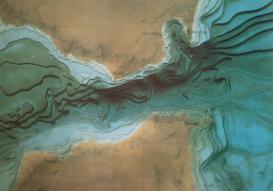What does it mean to hear underwater and how has it changed in the last 100 years? This question is best answered by paying close attention to technologies for submarine detection. They first transformed ultrasonic waves into sonic frequencies that sonar operators could listen to and, through extensive training, learn to identify. While active sonar generated pings that allowed locating echoing targets, passive hydrophones unveiled a wealth of sounds up to that point undetected beneath the ocean’s surface. Some of the largest research programs in oceanography during and after WWII attempted to tackle the intricacies of sound propagation underwater. Oceanographers from all over the world engaged in transnational efforts of mapping currents, temperature shifts, and the composition and topology of the ocean floor.
In the midst of the Cold War, the US Navy launched the Sound Surveillance System, a global network of hydrophones connected to central operation rooms that would go on to produce a catalogue of Soviet submarines classified according to their sound signatures. The auditory skills of the sonar operator were complemented with, and at times replaced by, graphic descriptions of frequency produced by the LOFARgrams. When part of this big global data was declassified and disclosed to civilian scientists, marine biologists were confronted not only with more information than they could easily compute, but also with new ways of hearing to mammals’ signals. Moreover, environmental scientists began to rely on this extensive network of listening devices, and the oceanographic studies they made possible, to conduct their own research on climate change.
This project aims at producing a history of underwater acoustics attentive to its agents’ practices and experiences of nature through technology. From the sonar operators on board a fighting submarine to a surveillance system in a given strait, strategically and scientifically controlling the local site where data was being produced was crucial for effective surveillance as well as for yielding global pictures of the environment.

